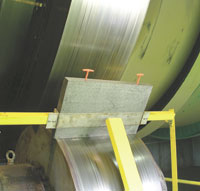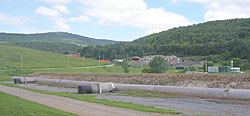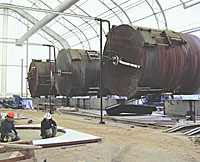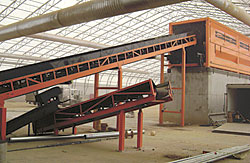 BioCycle November 2009, Vol. 50, No. 11, p. 23
BioCycle November 2009, Vol. 50, No. 11, p. 23
Twelve facilities composting mixed municipal solid waste in the U.S. continue to fill a niche, turning difficult waste streams into useful product.
Rhodes Yepsen
COMPOSTING mixed municipal solid waste (MSW) is an attractive solution for many communities that want to divert organics from landfills, but don’t have the population density to support a source separated organics (SSO) scheme. These facilities are capital intensive and not always successful, however. About half of the facilities constructed in the U.S. in the last 25 years have closed, with only 12 remaining. Most recently, the plant in Cobb County, Georgia, built to process 200 tons/day of mixed waste, was converted into a materials recycling facility (MRF).
“In the European Union we’re seeing a push for biomechanical waste processing, but that’s in response to mandatory landfill diversion goals,” says Robert Spencer, an environmental planner who helped start up a few MSW composting facilities, including Cobb County. “Without a mandate, economics rule, and right now there aren’t many places in the U.S. with the right conditions.”
Ultimately, the success of MSW composting facilities comes down to site-specific circumstances, such as area landfill fees, local government commitment and possible markets for MSW compost. “There are several variables that can be controlled, such as installing sophisticated screening technology,” says Spencer. “Also, the most successful plants in the U.S. are co-sited with a landfill, which allows for internalized residuals disposal cost and a destination for possible off-spec compost as cover material.”
The MSW composting facility in Delaware County, New York is colocated with a landfill, and Susan McIntyre agrees that this is significant. “Quite a few municipalities tour our MSW composting facility and are interested, but it’s difficult to determine how viable it would be for them,” says McIntyre, Solid Waste Director of the Delaware County, Department of Public Works. “We are uniquely advantaged – isolated, high organics waste stream content, and we can control the waste because we own-operate the adjacent landfill, meaning we aren’t dependent on tip fees to make revenue or meet payroll.”
Sevierville, Tennessee recommitted to MSW composting after its facility burnt to the ground in 2007. The recently reopened plant is also co-sited with a landfill. Tom Leonard reflects on the decision to rebuild. “Sure, it’s a challenge to make something out of what most communities just bury,” says Leonard, Solid Waste Manager for the City of Sevierville. “While rebuilding the facility, we buried our waste in the landfill, and it was definitely a lot easier than the composting process. But now that our system is running again, we are making something of that waste.”
This year’s BioCycle survey found only one request for proposal (RFP) for a MSW composting facility, in Gillette, Wyoming. Table 1 provides summary data for the 12 facilities in the U.S. Updates on each facility are below.
GILROY, CALIFORNIA
Z-Best Composting Facility processed about 300 tons/day of MSW from San Jose in 2009, down from 350 tons/day in 2008. Material first goes through a material recycling facility (MRF) in San Jose, with screened organics sent to the composting plant in Gilroy. (See accompanying article in this section, “Whole System Organics Recovery,” page 31). “We accept material six days per week, and are becoming more selective, looking for cleaner materials,” says Michael Gross, Marketing Manager for Zanker Road Resource Management, Ltd., which owns the Z-Best plant. “We’re also working on a public awareness program. Our finished compost sold well this year, marketed for landscaping and horticulture applications, whereas our compost from yard trimmings is sold for food production.” Zanker is in the permitting process for a dry anaerobic digestion (AD) facility, which would process the organics prior to composting.

MARIPOSA, CALIFORNIA
The Mariposa County Landfill, Compost Facility and Recycling Center accepts 60 to 100 tons/day of MSW in the summer, which drops off to about 30 tons/day in the winter. Mariposa County has only 18,000 residents, so most of the material is generated by the 3.5 million visitors to Yosemite National Park. SV Composter vessels from Engineered Compost Systems (ECS) are used. No equipment changes were made at the facility in 2009, although a consultant was hired to help reevaluate the processing/sort line.
Delaware North Company (DNC), Yosemite’s concessionaire, and Total Waste Systems, the franchise hauler, have been working with Mariposa County to develop a commercial food waste program for Yosemite National Park. “DNC’s hotels in the park have switched to compostable products, such as cutlery, clam shells and hot cups, and they collect food waste in colored compostable garbage bags that can be easily differentiated from garbage,” says Michelle Miller, Solid Waste and Recycling Manager for Mariposa County Public Works. “These materials help produce a better end product and require less processing.”
To reduce residential use of plastic bags, the “Got your Bag” campaign was launched, with stencils on grocery store parking lots to remind people to bring reusable bags with them when they shop. Grants from the California State Department of Conservation have sponsored education and outreach programs to encourage recycling. This includes Bin Buddies, which allow nonprofit organizations to adopt California Redemption Value (CRV) recycling containers around the community, and keep the proceeds; and event bins that can be checked out for festivals, parties, etc., to collect CRVs. “We also have a clothing recycling program and have recycled almost 35 tons of clothing since the program started in November 2008,” says Miller. “This reduces the types of items that can get caught in the processing machinery at the plant.”
MARLBOROUGH, MASSACHUSETTS
The Marlborough composting facility is owned and operated by WeCare Environmental LLC. The facility increased its throughput from 2,000 tons/month to 3,000 tons/month in 2009; that includes 20 to 23 tons of biosolids. Materials are processed in a rotating drum and then in aerated windrows in a composting hall. “We’re working hard to increase our tonnage, taking in excess biosolids from other facilities, and increasing the amount of mixed MSW,” says Phil McCarthy, Facility Manager at Marlborough. “Although we were more selective in the past, the economics of running the facility have required us to take in MSW loads with more contamination, resulting in about 35 percent residue.”
Last year the facility reported 20 to 25 percent residue, and was accepting loads of source separated organics. McCarthy explains that sources of pure organics are currently limited in the area, and often are taken by facilities with simple technologies and lower fees, such as farms. To maintain the quality of the finished compost, operators are paying extra attention to materials on the tip floor, and are talking to residents and haulers about presorting. Finished compost is primarily sold in bulk to commercial soil blenders.
NANTUCKET, MASSACHUSETTS
The Island of Nantucket was recently heralded as having the highest waste diversion rate in the country, clocking in at 92 percent, up from 85 percent last year. “The improvement can be attributed to more participation in recycling, more enforcement of separation and increased efficiency at our facility,” says Nathan Widell, plant manager for Waste Options, Inc., which manages the island’s landfill, MRF and MSW composting facility. “The residents are increasingly aware of the value of recycling, and we’re training our haulers to not accept garbage with glass or tin cans. Clear plastic bags must be used for MSW to enter our composting facility.”
Overall, Nantucket’s MSW generation in the summer months dropped off by 20 percent, due to a decrease in tourism, resulting in a peak throughput of 80 tons/day, and 15 tons/day off-peak (including biosolids). The composting facility screens out about 25 percent of residuals, which is mostly plastic. Waste Options has considered installing a bag breaker and having a picking line to remove more plastic, but also would like to see the island commit to using compostable bags.
Improvements in the past two years include new blowers for the aerated windrows, biofilter maintenance and screen repairs. “Our compost was always fairly free of glass and plastic, but now it is even cleaner, simply from fine tuning the existing system and replacing worn items such as bearings and springs,” explains Widell. The composting facility uses an air classifier, a bivi-TEC vibrating deck screen and a Forsberg destoner. “We’ve also become more systematic about water use, installing a gauge to monitor how much goes in, and are more consistent with the feed of biosolids, resulting in a better finished product.” Of the 15,000 cubic yards (cy) produced, approximately half is sold for $15/cy, with the balance used for landfill capping and facility landscaping.
Nantucket was the first composting facility in the U.S. to earn carbon credits (see “Composting Generates Cash For Greenhouse Gas Benefits,” June 2009). “We’ve kept meticulous daily time and temperature records since we started, and have always been in compliance with our permits, which was really important for being approved for carbon credits,” notes Widell.
In addition, Waste Options began mining the island’s old unlined landfill. “Prior to Waste Options taking over the operation and constructing a composting facility, everything was dumped in the old landfill, including MSW, biosolids and bulky items,” says Widell. “We are now mining that material, screening it for structural fill, as well as wood, metals and eventually plastic. The structural fill is tested for contaminants every 1,000 yards.”
TRUMAN, MINNESOTA
Prairieland Compost Facility in Truman is processing a little less MSW than last year, at 64 tons/day. The waste is sent through a grinder, screened and then composted in agitated bays. “We don’t have a population base for SSO, but we do sometimes get loads of food waste from processors,” says Mark Bauman, Director of Prairieland. “This might be contaminated loads of food waste that other composters don’t want, floor scrapings, off-spec vegetables, food in damaged packaging, etc. It’s seasonal, but sometimes we’ll get 20 tons/week for two months.”
Bauman would like to expand more into refuse derived fuel (RDF) from the residuals, and hopes to have more RDF contracts signed in the first quarter of 2010. About 3,000 tons/year of finished compost is produced, which is given away locally. “Some residents pick it up, and farmers in the area love it, but it’s free, so what’s not to like,” he says. “Public perception is low, despite our education and outreach. It’s Class II compost, usually because of a few parts per million (ppm) of lead. The limit for Class I is 300 ppm, and we average between 270 and 340 ppm.”
WEST YELLOWSTONE, MONTANA
The totally enclosed composting facility in West Yellowstone has been operating since 2003, primarily servicing Yellowstone National Park. Located at the Gallatin County transfer station near the West entrance to Yellowstone and built on a closed landfill, the composting plant was designed to process 6,000 tons/year of mixed waste. About 90 percent of that MSW flow comes in from late June through early September. “Basically, the designed system is at overcapacity in the summer and underutilized the remainder of the year,” says Kathy O’Hern, who recently left her job as plant manager to join the Montana Department of Environmental Quality.
The 2008 MSW Composting Update included a detailed article on the plant (see “West Yellowstone Tackles Composting Challenges,” November 2008). Operationally, there haven’t been any significant changes since then. Generators separate waste into two streams – organics in a clear bag, and inorganic material in a blue bag. After loads are tipped, an excavator operator removes the blue bags (for landfill) and pushes the clear bags onto the pit conveyor that feeds a drum where moisture is added to facilitate pulping. The 7-inch minus fraction is conveyed to a Luck/Now Mixer, where manure, wood chips and straw and hay are added. “The facility originally received biosolids, but that was problematic for the coreless auger conveyors,” explains O’Hern. “The biosolids would work their way under the UHMW liner because the glass in the MSW would cut holes in it. That would eventually fault the motor and cause maintenance challenges, so we stopped taking them. West Yellowstone is planning to change out the coreless auger conveyors and accept biosolids.”
West Yellowstone has seven ECS aerated concrete vessels, each 60-feet long by 10-feet wide by 10-feet high. After 14 days, the material is moved to a negatively aerated curing floor. Windrows are turned weekly in a progression down the floor; moisture is added as needed. After roughly six weeks, compost is fed into a bivi-TEC screen with 3/8-inch screen panels. It then passes through a Forsberg air classifying destoner and is screened a second time. Compost markets include Yellowstone National Park (e.g., for revegetation projects), gardeners, landscapers and building contractors.
While the composting system has been fine-tuned and operates with relatively minimal challenges, the partners who joined together to build the plant – Gallatin County and the National Park Service – want to address the constraints on the facility’s capacity in the summer months, especially with regards to having to turn away SSO streams such as food waste. “An additional consideration is that during the winter, the building is held just above freezing, but it still costs $30,000 to keep it from going into a deep freeze,” explains O’Hern. “For these reasons, we began evaluating anaerobic digestion (AD) for the first stage of processing.”
Anaerobic digestion would preprocess the nitrogen-based waste – food, manure and landscape – and reduce the volume of the incoming material going into the composting vessels by up to 40 percent, she adds. Digested organics would be mixed with ground wood and loaded into the compost tunnels. “The volume reduction due to the AD phase would enable West Yellowstone to accept more organic material in the summer and potentially operate during the winter months by processing the SSO,” says O’Hern. A combined heat and power system could offset the heating demand during the winter. West Yellowstone is evaluating the dry fermentation AD technology.

 DELAWARE COUNTY, NEW YORK
DELAWARE COUNTY, NEW YORK
Designed by GHD (formerly Stearns & Wheler), the Delaware County composting facility is running smoothly, on target to process the same throughput as 2008: 24,000 tons of MSW and 7,000 tons of biosolids. MSW entering the facility is dropped onto a grizzly mill before entering a rotating drum, manufactured by Conporec. After three days, the material is screened and then composted in IPS-Siemens agitated bays. The building housing the operation is constructed of stainless steel to resist corrosion, and is under negative pressure.
The facility’s rotating drum had its first crack this year, but was successfully mended. Also on the drum, a graphite block is now used for lubrication instead of grease, which is cleaner and requires less maintenance. A new temperature monitoring system was installed in the compost maturation area, replacing the existing thermocouples with RTDs (resistance temperature detectors). “Thermocouples are inexpensive and relatively accurate, but require a signal translator, and we were having issues with reliability,” says Susan McIntyre. “When our temperatures were off we didn’t know if it was just a bad signal, and had to go into the active composting zone to take temperatures by hand. The RTDs, provided by Athena Controls, are hard wired to a small LCD panel without a signal translator, providing more accurate readings that can be downloaded onto a computer.”
Other changes include replacing the biofilter media, which took three days this summer. One of the biggest changes made in 2009 was purchasing a second Siemens agitator. “Although only one unit will be running at a time, this allows for preventative maintenance, and a spare in the event of breakdown,” says McIntyre.
Compost sales were strong this year (see “Marketing Mixed Waste Compost,” page 29), and Delaware County plans to increase its throughput in 2010, accepting loads of SSO. “We have the capacity, a new agitator and several years of successful MSW management, so we’ll be accepting SSO streams on a case-by-case basis,” she adds. For example, Delaware County will take food waste from the upcoming New York State Association for Reduction, Reuse and Recycling (NYSAR3) conference in November.
MEDINA, OHIO
Medina County’s Central Processing Facility (CPF) receives 350 tons/day of residential and commercial MSW, as well as 200 tons/day of C&D debris. The MSW is sorted for recyclables using an electromagnet, eddy current and picking lines before entering a trommel screen, sized at two-inch minus. An air classifier is used to blow out lightweight plastic before the MSW enters the composting facility. The recovered plastic, about 20 to 25 tons/day, is used to make RDF. Approximately 33 tons/day of the MSW (what remains after all the processing) are composted in windrows, mixed with 66 tons/day of yard trimmings and wood chips from the county’s Class IV composting site.
“We have a bid opening for plant operation for the next five years, so things could change in 2010,” says William J. Strazinsky, Medina County Solid Waste District Coordinator. “Until then, we’re still looking for more users of RDF. We use most of the finished compost as alternative daily cover (ADC) at the landfill.”
Rapid City, South Dakota
The Rapid City composting facility processes about 180 tons/day of MSW, combined with 60 tons/day of liquid biosolids. These materials are mixed in two Dano drums, and then composted for 28 days in nine IPS-Siemens agitated bays. The compost is cured in an open-air building.
“Nothing major has changed in 2009, although we are replacing the media in our biofilter,” says Mike Oyler, Plant Supervisor. “The biofilter was constructed in 2003, when the facility opened, and we’ve had to replace the media once before, but this time we are using less wood and more rock, with the hopes that it will work better.”
Rapid City has a new arrangement with Gillette, Wyoming, in which it accepts commingled recyclables into its MRF in exchange for MSW compost. “Gillette has experienced tremendous population growth, jumping from 12,000 people in 1990 to 32,000 in 2007, and total MSW generation has increased about 12 percent per year,” says Mark Swan, with the Campbell County Department of Public Works. “We are at maximum capacity for MSW, C&D and recyclables, and were looking for options before a new facility could be constructed. We struck a deal with Rapid City where we bring them our commingled recyclables, minus cardboard and paper, about every 10 days. They accept them at no cost and market the materials, and we return to Gillette with a free 20-ton load of MSW compost, which is used for reclamation projects at our landfill. Even considering the 150-mile drive each way, we save $50,000 to $70,000 per year.” Gillette currently has an RFP out for a strategic solid waste management plan, and is considering MSW composting as an option.

 SEVIERVILLE, TENNESSEE
SEVIERVILLE, TENNESSEE
A massive fire in 2007 destroyed most of Sevier County’s MSW composting facility (see “Tennessee Composting Facility Rises From The Ashes,” November 2007). After a year of reconstruction, the plant officially reopened on May 20, 2009, and is once again composting 250 tons/day (including 50 wet tons/day of biosolids).
The facility essentially works the same as before, with MSW loaded into one of five rotating drums for three days, screened, then composted in windrows. However, many aspects are new and improved. “The fire destroyed everything except for our rotating drums, loaders and bobcat,” says Tom Leonard. “The biggest difference is that we more than doubled the size of our building, from 88,000 square-feet in the old one to 190,000 square-feet in four new buildings. This allows us to operate more efficiently and produce a lot more finished product from the same throughput of materials.”
Leonard explains that when the old facility was originally designed, material was composted in aerated static piles. They switched to windrows due to problems with wall-mounted fans, piping, etc., but the building didn’t have enough space for the number of windrows needed. “This meant there wasn’t enough drying time, so when we screened our compost, it was too moist and the overs had a high percentage of wasted compost,” he continues. “We had less material, and it was lower quality, typically used for ADC. Now we have a lot of good finished compost.”
The fabric buildings, manufactured by Cover-All, are resistant to corrosion and kept under negative pressure, with air sent to two separate biofilters. Electrical lights were installed, but natural light is sufficient during the daytime. Before the new buildings were constructed, Leonard took advantage of the easy access to the drums and replaced 80-foot sections in the middle of two older units. “Those two drums were 50-years-old when we installed them, with one coming from a cement plant in Florida, the other from Virginia,” he explains. “We couldn’t access them even with a crane while the buildings were in place, so we took the opportunity after the fire to refurbish them, using AC Equipment for the replacement sections.”
While some fire-damaged equipment, such as the Backhus windrow turner, was replaced with identical models, the screening equipment was changed. In the old system, material left the rotating drums and fell onto a series of conveyors leading to an ancient trommel screen. “The screen was so old that nobody could identify the manufacturer, which became an issue when we wanted to do some repairs,” says Leonard. “Having multiple conveyors also caused a host of problems, with a fence post or other bulky items getting caught and jamming the whole system for hours. Now it’s a straight shot from the drums to a Doppstadt trommel screen, with a wide conveyor, which works much better.”
The Doppstadt sits 16 feet high, with fines dropping on the floor; a conveyor delivers overs into a container. “It takes 30 minutes to fill a container, with the conveyor rotating back and forth for even distribution,” notes Leonard. “We’ve slowed the screening process down as much as possible, taking 12 hours if possible since we have 12 hour shifts. This provides us with cleaner overs, so that some recyclables can be salvaged, and more organics enter the composting process.”
A loader picks up the organics and forms windrows. Material is composted for 38 days, using the Backhus turner. Finished compost is then screened with a new 8- by 12-foot Liwell flip deck machine. “This screen works far better than our old trommel, which would blind when the moisture content of the compost went above 37 percent,” says Leonard. “The flip deck has plastic mat screens that are easy to clean and literally flip, bouncing out pieces of glass and plastics.”
Overall, 35 percent of incoming MSW exits the facility as residuals. Finished compost is primarily sold to soil blenders and farmers. “We are also meeting with an ethanol company that is working with farmers to increase the production of switchgrass, possibly by using our compost,” says Leonard. “With switchgrass, unlike crops like wheat, there is no crop residue left on the field for returning material to the soil. Our compost could provide that organic material and improve production for the ethanol plant.”
COLUMBIA COUNTY, WISCONSIN
The Columbia County Recycling and Waste Processing Facility hasn’t made any changes in 2009, receiving between 75 and 80 tons/day of MSW. Opened in 1992, the facility processes MSW in two rotating drums, each with a capacity of 250 tons. The drums have spikes for opening bags, and moisture is added for proper mixing. After five days, the material exits the drum and is screened. Residuals are compacted and sent to landfill, and organics are transferred to a storage building for composting. Windrows are turned about two or three times per week for a total of eight weeks, during which temperatures reach 150°F. Finished compost is screened again, prior to being given away to farmers and landscapers. About 3,000 tons/year of finished product are produced.
November 19, 2009 | General










